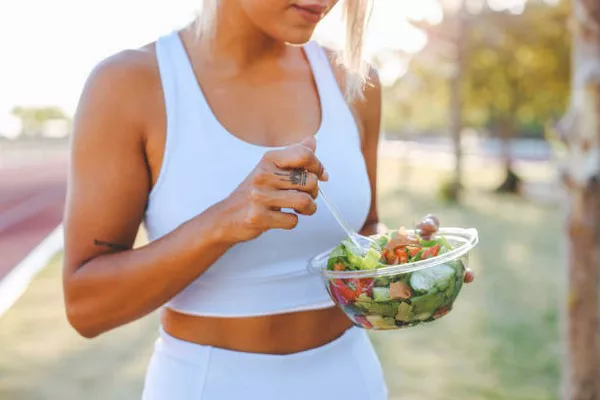Losing arm fat involves a combination of diet, exercise, and healthy lifestyle choices. This article will guide you through specific dietary recommendations, emphasizing whole foods, balanced nutrition, and strategic eating habits to help you achieve your goals.
Understanding Arm Fat
Before diving into dietary suggestions, it’s important to understand what arm fat is and why it accumulates. Arm fat, like fat in other areas, is primarily due to an excess of calories consumed over calories burned. Hormones, genetics, and overall body composition also play roles.
Caloric Deficit: The Key to Fat Loss
To lose fat, including arm fat, you need to create a caloric deficit. This means consuming fewer calories than your body needs to maintain its current weight. A combination of diet and exercise is the most effective way to achieve this.
Macronutrient Balance
Balancing macronutrients—proteins, carbohydrates, and fats—is essential for overall health and effective fat loss.
Protein
Protein is crucial for muscle repair and growth, and it helps keep you full longer, reducing overall calorie intake.
- Lean Meats: Chicken breast, turkey, lean cuts of beef
- Fish: Salmon, tuna, cod
- Plant-Based Proteins: Beans, lentils, chickpeas, tofu, tempeh
- Dairy: Greek yogurt, cottage cheese, low-fat milk
Carbohydrates
Choose complex carbohydrates over simple sugars for sustained energy and better nutrient intake.
- Whole Grains: Brown rice, quinoa, whole wheat bread, oats
- Vegetables: Broccoli, spinach, kale, bell peppers
- Fruits: Berries, apples, oranges, pears
Fats
Healthy fats are necessary for hormone production and overall health. Opt for unsaturated fats.
- Nuts and Seeds: Almonds, walnuts, chia seeds, flaxseeds
- Oils: Olive oil, avocado oil
- Fish: Salmon, mackerel, sardines
- Avocado
Micronutrients
Vitamins and minerals play a critical role in metabolism and overall health. Ensure a varied diet to cover your micronutrient needs.
Hydration
Staying hydrated is vital for metabolism and helps control hunger. Aim for at least 8 glasses of water per day.
Specific Foods to Include in Your Diet
Leafy Greens
Leafy greens are low in calories and high in fiber, which helps you feel full without consuming excess calories.
- Spinach
- Kale
- Swiss Chard
Cruciferous Vegetables
These vegetables are nutrient-dense and contain fiber, which aids in digestion and satiety.
- Broccoli
- Cauliflower
- Brussels Sprouts
Whole Grains
Whole grains provide sustained energy and are more nutrient-dense compared to refined grains.
- Oats
- Brown Rice
- Quinoa
Lean Proteins
Lean proteins help build and maintain muscle mass, which can increase your basal metabolic rate.
- Chicken Breast
- Turkey
- Tofu
Healthy Fats
Healthy fats support overall health and can help keep you satiated.
- Avocado
- Olive Oil
- Nuts
Berries
Berries are high in fiber and antioxidants, supporting overall health and aiding in weight management.
- Blueberries
- Strawberries
- Raspberries
Meal Planning Tips
Breakfast
Start your day with a protein-rich breakfast to boost metabolism and reduce hunger throughout the day.
Example: Greek yogurt with berries and a sprinkle of flaxseeds.
Lunch
Include a balance of protein, healthy fats, and complex carbohydrates.
Example: Grilled chicken salad with mixed greens, quinoa, avocado, and olive oil dressing.
Dinner
Focus on lean proteins and plenty of vegetables.
Example: Baked salmon with steamed broccoli and a side of brown rice.
Snacks
Opt for nutrient-dense snacks that provide sustained energy.
Example: Apple slices with almond butter or a handful of mixed nuts.
See Also: What Snacks To Eat At Night To Lose Weight
Eating Habits
Portion Control
Be mindful of portion sizes to avoid overeating. Use smaller plates and avoid second servings.
Mindful Eating
Eat slowly and savor your food. This helps you recognize fullness cues and prevents overeating.
Regular Meals
Stick to regular meal times to keep your metabolism steady and avoid extreme hunger.
Foods to Avoid
Sugary Foods
Sugary foods can lead to weight gain and should be limited.
Examples: Sodas, candy, pastries
Processed Foods
Processed foods often contain unhealthy fats, sugars, and sodium.
Examples: Fast food, chips, pre-packaged meals
Refined Carbohydrates
Refined carbohydrates can cause blood sugar spikes and contribute to fat storage.
Examples: White bread, pastries, white rice
Incorporating Exercise
While diet is crucial, exercise complements your efforts to lose arm fat. Include both cardiovascular exercises and strength training.
Cardiovascular Exercises
Cardio exercises help burn calories and improve heart health.
Examples: Running, cycling, swimming
Strength Training
Strength training builds muscle, which can increase your metabolism and aid in fat loss.
Examples: Weightlifting, resistance band exercises, bodyweight exercises
Tracking Progress
Monitor your food intake and physical activity to stay on track. Use a journal or mobile app to log your meals and workouts.
Conclusion
Losing arm fat requires a holistic approach involving a balanced diet, regular exercise, and healthy lifestyle habits. Focus on consuming nutrient-dense foods, maintaining a caloric deficit, and incorporating both cardio and strength training exercises into your routine. With consistency and dedication, you can achieve toned and lean arms.


